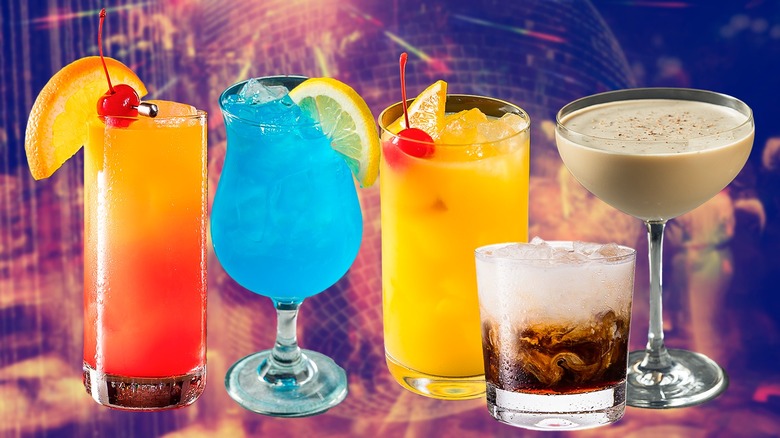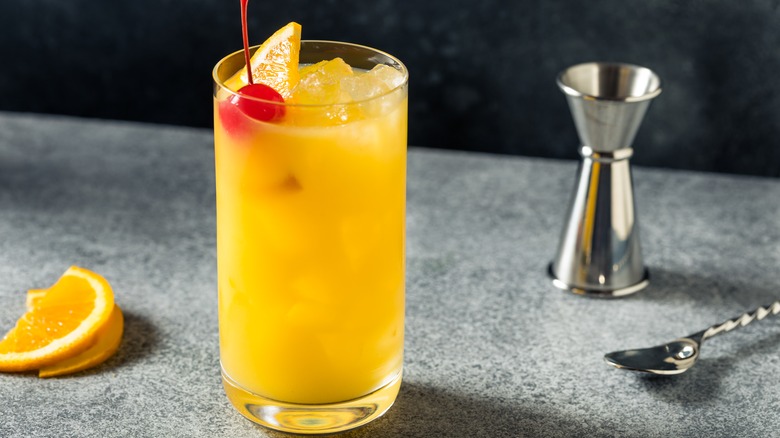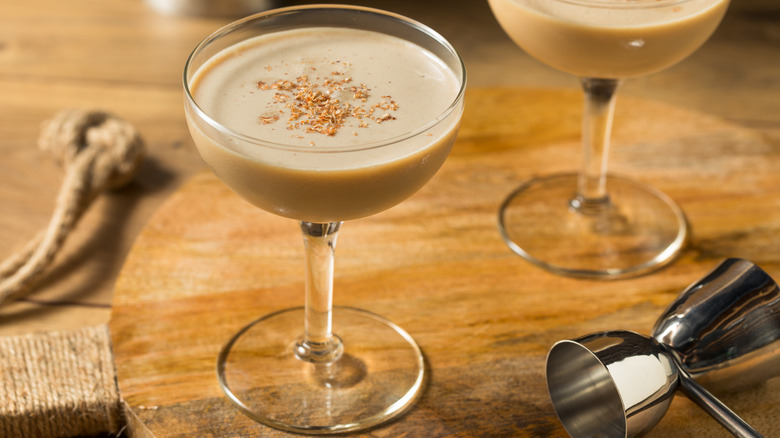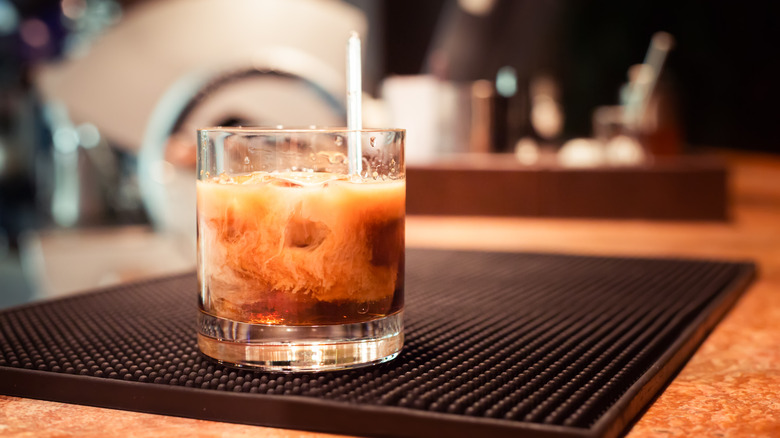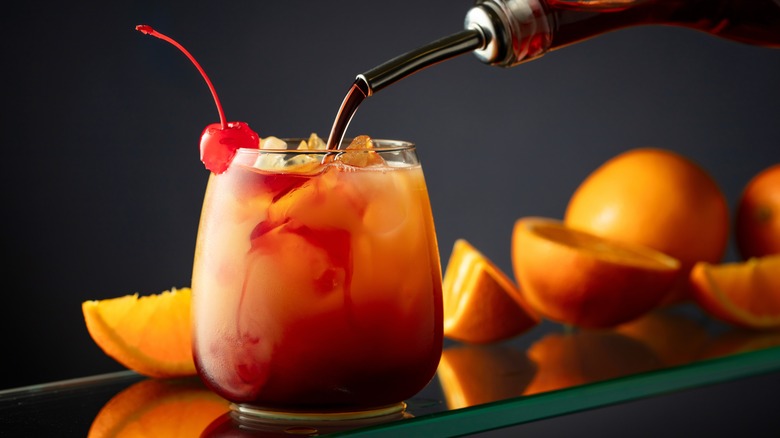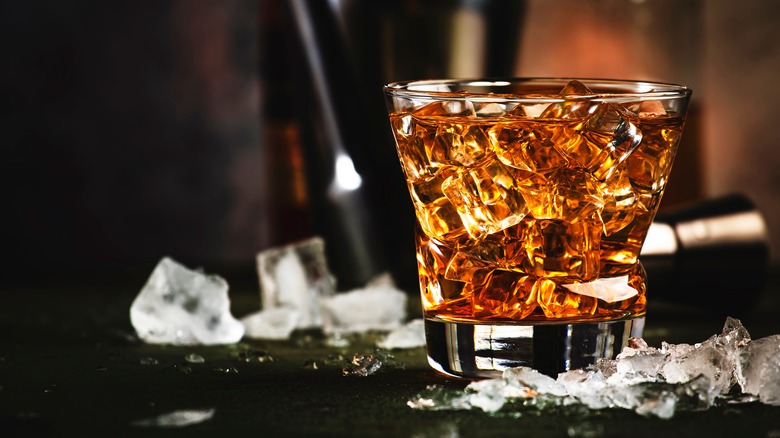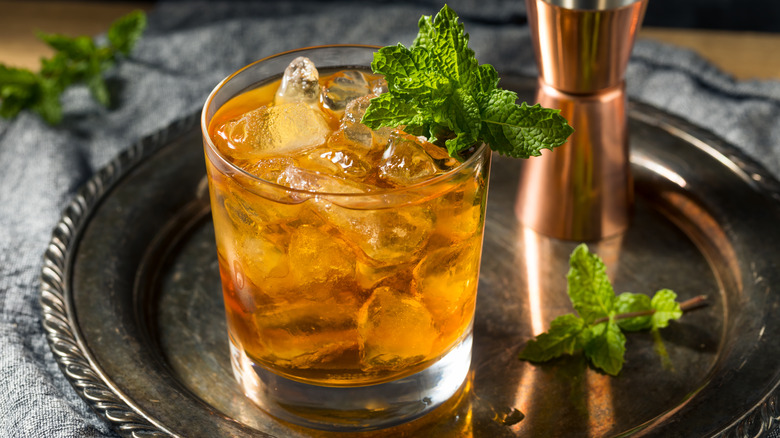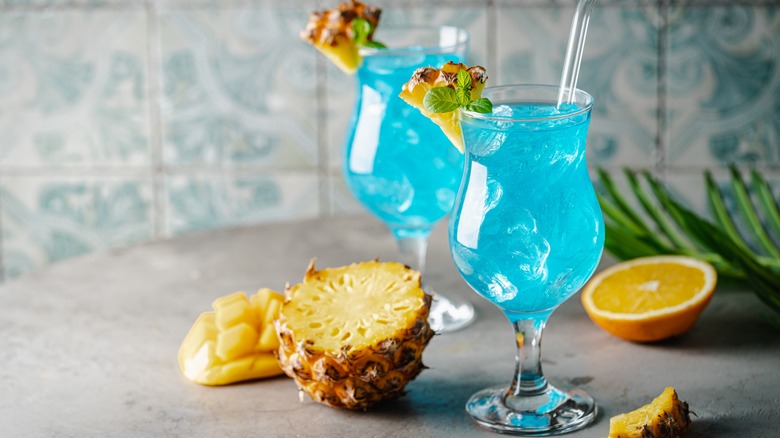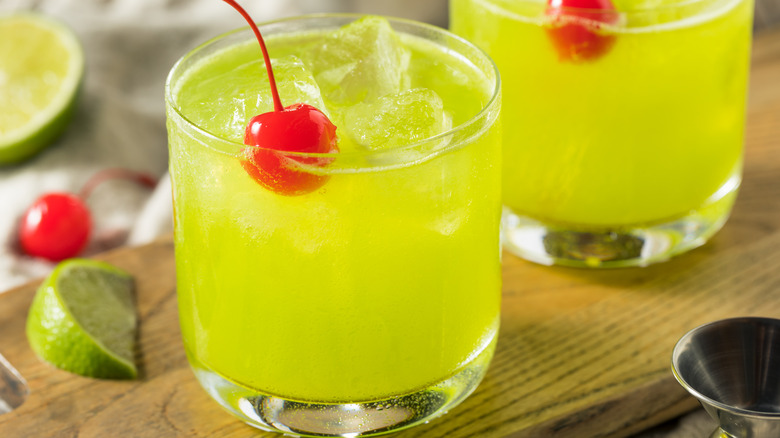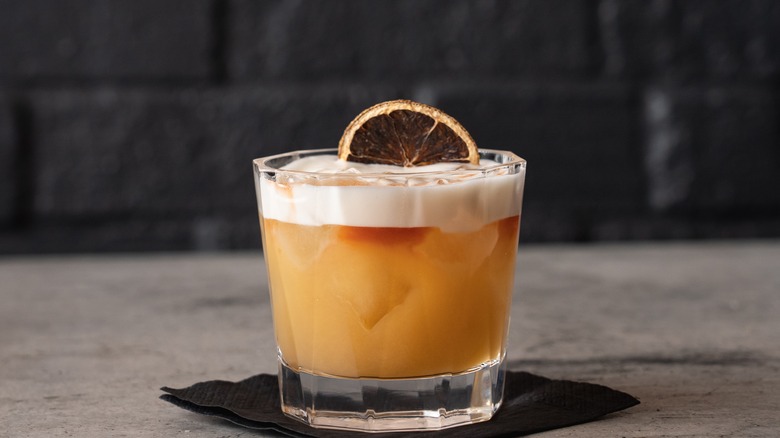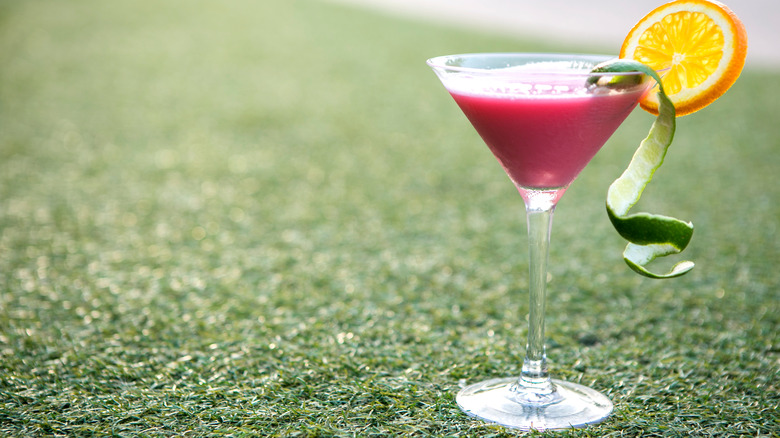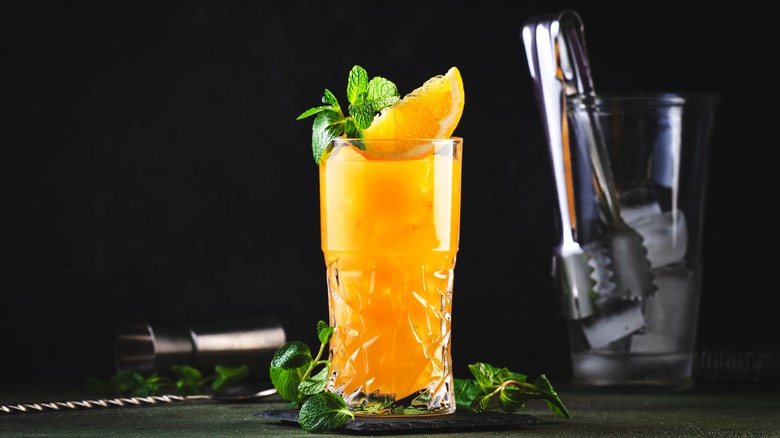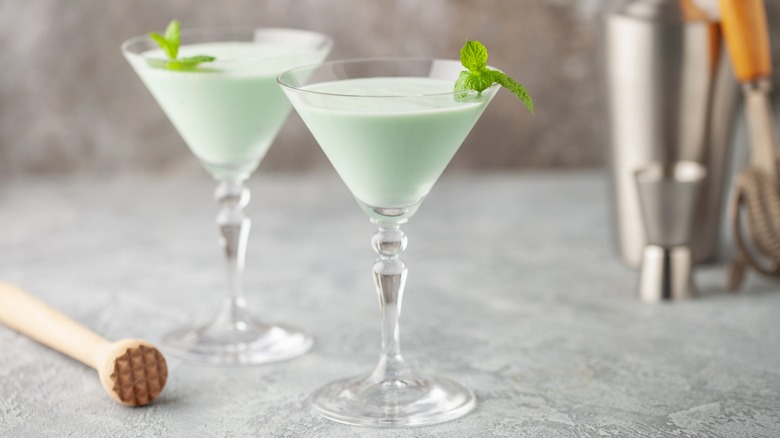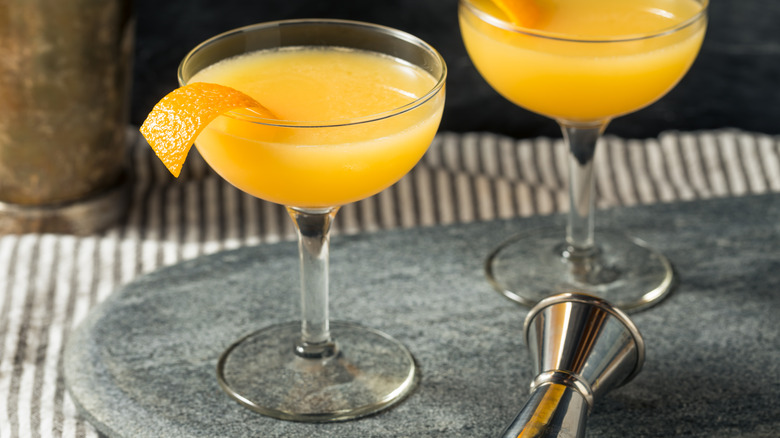13 Disco Drinks That Will Transport You To Groovier Times
Anyone who got into the groove of disco culture in the 1970s probably has fond memories of late nights spent dancing in the club. Aside from becoming a booming music genre in the decade, the "disco" atmosphere offered a hub for liberal self-expression, especially given its roots in the decade's Black and gay cultures. Disco invited everyone and everything to stand out — hair got bigger, bellbottom jeans got wider, platform shoes grew taller, and it seemed a point of participating in the scene was to make yourself noticeable. It only makes sense that groovy, electric cocktails would also spike in popularity.
Disco cocktails often, though not always, shared a few notable characteristics. They tended to be bright in color and vodka was the primary liquor used, due to its rising popularity in the '70s. The drinks mimicked the vibes of the time: carefree, lively, and fun. They were often super sweet, artificially flavored, and easy to drink. Iconic '70s cocktails ushered in a free-spiritedness that seems to have since been lost to the throes of time. Fortunately, the drinks themselves haven't slipped into obscurity, and if you want to get yourself into the disco mindset, sipping on a groovy cocktail is a surefire way to do it.
Harvey Wallbanger
Contrary to the cheery vibes of the time, the origin mythology behind the Harvey Wallbanger cocktail is a little less bright. As the story goes, '50s surfer Tom Harvey dropped by a bar after losing a surfing competition and ordered his favorite drink: a mix of vodka, orange juice, and bright yellow Galliano. He sipped it and, upset from losing the competition, proceeded to bang his head against the wall. Thus, the now-famous drink got its name: the Harvey Wallbanger.
Whether or not you believe the drink's origin legend, it's undeniable that the Harvey Wallbanger made a lasting impression on '70s culture. It was bottled, served as inspiration for cakes, and even got characterized as a cartoon. It's not hard to see why the Harvey Wallbanger gained widespread appeal; similar to other cocktails of the time, it boasted a bright hue and capitalized on vodka as its primary liquor. Galliano, an Italian liqueur, adds an interesting element to the drink with its vanilla and anise notes. You can make your own Harvey Wallbanger at home by mixing 1½ ounces of vodka with 4 ounces of orange juice, and floating a ½ ounce of Galliano on top.
Brandy Alexander
Though not as brightly colored as many of its contemporary cocktail contenders, the Brandy Alexander still managed to earn its rightful spot in '70s disco culture, likely because it capitalized on then-popular creme de cacao. Though it gained popularity in the '70s, the roots of the Brandy Alexander actually go back decades earlier, when it was originally just called the Alexander. The invention of the early-1900s Alexander cocktail is often credited to Troy Alexander, a bartender who created the cocktail to celebrate a railroad's successful marketing campaign.
The earliest version of the Alexander used gin as its liquor of choice; later on, gin would be traded for brandy, and the Brandy Alexander was born. Aside from its color, this cocktail had all the qualities appreciated by '70s partygoers — namely, it was sweet and thick, often compared to a milkshake. It's also very possible that the drink became so popular after becoming a favorite of John Lennon. Want to try this tasty treat for yourself? Shake together 1½ ounces of Cognac, 1 ounce of creme de cacao, and 1 ounce of heavy cream; strain into a coupe glass and garnish with nutmeg.
White Russian
One of our personal favorites, the White Russian, found a serious foothold in the 1970s, though it's believed to have been created in the decade prior. Similar to our last pick, the appeal of the White Russian was simple — it's sweet, thick, and creamy, making it a shoo-in for the decade's most popular drinks. The drink tastes much like a dessert, and it was effortlessly drinkable for the '70s disco dance scene.
Traditionally, a White Russian is made by combining two parts vodka, one part Kahlúa, and one part heavy cream. We're willing to bet that the relatively simple cocktail will always have staying power in the bar scene, but modern times have called for modern re-imaginings of the popular drink. You could elevate your White Russian in several ways, but one of our favorites is nearly as simple as the original: Simply stir homemade whipped cream and a sprinkle of cinnamon into a White Russian to give it a tiramisu twist. Other variations make different modifications to the drink, like substituting the cream for a carton of chocolate milk, or simply adding Irish cream liqueur to make it a mudslide.
Tequila sunrise
The tequila sunrise was a no-brainer success in the '70s, especially given the popularity of using orange juice as a mixer during the decade. The vibrant orange hue of the orange juice layered with bright red grenadine no doubt played a role in the success this drink saw during the decade — true to its name, it looks delightfully inviting, like a sunrise. Its cultural prominence also must have played a role in the widespread enjoyment of the drink. Mick Jagger was seen enjoying the drink in San Francisco in 1972, and in 1973, the Eagles' hit song "Tequila Sunrise" was given to the masses.
You can make a tequila sunrise with ingredients you likely already have on hand. All you need is tequila, orange juice, and a splash of grenadine — feel free to adjust the ratios until the drink suits your palate. As with other cocktails on this list that have withstood the test of time, the tequila sunrise has evolved to become a drink many enjoy making alterations to. For example, you can give the cocktail a simple, sophisticated twist by adding a splash of orange blossom water to your tequila sunrise.
Godfather
If you think you have a sneaking suspicion where the popular 1970s drink the Godfather got its name, you just may be correct. That's right — the Godfather is named after the classic movie released in 1972, and no doubt grew in popularity due to being a rumored favorite drink of star Marlon Brando. You may have already noticed that the Godfather stands in stark contrast to other drinks on this list. It doesn't boast a bold hue, nor is it excessively sweet, fruity, or loaded with vodka. Rather, the drink is a testament to the chokehold the entertainment industry can have on pop culture, as we don't think it would have become nearly as popular had "The Godfather" not seen such extraordinary success.
The classic Godfather cocktail is simple: just mix equal parts amaretto and whiskey. But as you may have guessed, this cocktail hasn't stood the test of time without seeing its fair share of modifications, and nowadays, there's a wealth of ways to order the timeless cocktail. The Godchild uses cream in place of amaretto for a thick, dessert-like drink, while the Godmother replaces whiskey with vodka. Our suggestion? Try the plain ol' Godfather; then, play around with it until you've found your favorite variation of the classic.
Stinger
We think our next drink has a very fitting name, given its appearance. The bold golden hue of the Stinger looks as potent as poison and sharp as a tack. Though the drink gained popularity in the '60s and '70s, its history goes all the way back to the 1890s, when it was introduced under another name: the Bartholdi cocktail, named after the hotel in which it was conceived. Since then, the cocktail has enjoyed a long, rich history; it's even known as having been Billie Holiday's favorite cocktail. Though it retained its popularity through the early '70s, it declined in popularity towards the end of the decade.
The two-ingredient drink is easy enough to whip up on your own, provided you have the appropriate ingredients. All you have to do is combine ¾ ounce of white creme de menthe with 2 ounces of Cognac. The drink boasts some simple variations; for example, when made with green creme de menthe, it becomes the Emerald, while a chocolate version replaces Cognac with the chocolate spirit of your choice.
Blue Hawaii
The Blue Hawaii has an exciting, rich origin story, and though it hasn't been around as long as other drinks on our list, we bet its future longevity will more than make up for that. The Blue Hawaii was created in 1957 by Harry Yee, bartender at the Hawaiian Village hotel in Honolulu, Hawaii. Tourists visiting the area wanted cocktails that would enhance their carefree tropical experience, and Yee had been making an incredible amount of mai tai cocktails to pacify them. When liquor company Bols contacted Yee to help promote its new liqueur, Blue Curaçao, inventing the sweet, tropical Blue Hawaii must have been a no-brainer.
It's also not hard to see why this drink saw an ample '70s disco audience thirsting after it. Its electric blue hue, along with its tropical flavors, were enough to transport any disco dancer to a beachy lounge chair in just one sip. If you want to make your own (and stay true to the original), shake together the following: 2 ounces of pineapple juice, 1 ounce of Bols Blue Curaçao, 1 ounce of vodka, ½ ounce of fresh lime juice, and a dash of simple syrup. Though we think the original is delightful as is, if you wanted another slight tropical element, a dash of coconut syrup wouldn't be a bad addition.
Midori sour
Our next pick was introduced toward the end of the decade, but it still deserves a spot on this list given its near-immediate popularity and its resemblance to other iconic '70s cocktails. Though the Midori sour looks like it might be slightly radioactive, don't let that stop you from giving this cocktail a try. Midori, a bright green liqueur made from Japanese muskmelons and yubari fruit, was introduced to the U.S. via Studio 54 nightclub in New York City in 1978. Though it found quick popularity that lasted throughout the next decade, Midori liqueur used to take a back seat in the cocktail, as it was often overshadowed by a sweet and sour mix.
As decades have gone by, audiences have grown to have a greater appreciation for the distinct melon-flavored liqueur, and a more natural version of the drink has taken center stage. To make a Midori sour cocktail for yourself, stir together 1 ounce of Midori, 1 ounce of vodka, ½ ounce of fresh lemon juice, and ½ ounce of fresh lime juice, and pour a dash of club soda on top. If the base recipe leaves you wanting four more, try some variations on the Midori sour, like including muddled berries, jalapeño, mint, or coconut rum.
Amaretto sour
We couldn't mention the Midori sour without also paying due homage to the amaretto sour. It's commonly believed to have been invented in the 1970s, when Disaronno was marketing its amaretto liqueur. The original drink was a well-balanced mix of sweet and sour notes. Almond-flavored amaretto provided enough sweetness to the drink on its own, while the simple addition of fresh lemon juice gave the drink a well-rounded flavor profile.
Unfortunately, the joy of the simple amaretto sour would soon be usurped by the addition of sweet and sour mix, making this drink often overly sweet and too unpalatable for many cocktail enthusiasts. Other variations of the drink, however, add elements that help balance and enhance the original recipe's tasting notes; for example, bartender Jeffrey Morgenthaler adds bourbon and egg white to include creamy, smokey elements. Another admirable facet of this drink is that it can also be enjoyed sober. Make a no-ABV amaretto sour mocktail with orange juice, a lemon, almond extract, simple syrup, an egg white, and a maraschino cherry.
Pink squirrel
The pink squirrel cocktail looks tailor-made for the '70s, but it's believed to have been invented in the decades prior by Bryant Sharp, originator of Bryant's Cocktail Lounge in Milwaukee, Wisconsin. Regardless of the exact year of its invention, it's not hard to see why the cocktail had staying power throughout the '70s; its bold pink hue practically begged disco-goers to indulge on nights out. Beyond its bright colors, the sweet, rich flavor of the drink was also well-suited to the decade.
Unfortunately, you aren't likely to have all the ingredients for a three-ingredient pink squirrel cocktail on hand. The drink gets its pink hue from creme de noyaux, a stone fruit liqueur that the casual drinker probably has yet to enjoy. If you can get your hands on a bottle of the liqueur, we urge you to give the pink squirrel a try. Make it by shaking together ¾ ounce of creme de noyaux, ¾ ounce of white creme de cacao, and 1½ ounces of heavy cream. Strain into a coupe glass, and if you want a little garnish, add some grated nutmeg on top.
Screwdriver
Fans of the screwdriver cocktail know this drink needs no introduction. This cocktail is simple and straightforward, as its only ingredients are orange juice and vodka. What's less clear, however, is the true origin of the screwdriver. Varying legends attribute the drink's creation to mid-1900s American oil workers in the Persian Gulf, or World War II soldiers. We think it's possible all these origin stories are somewhat factual, given that they're placed around the same time, and vodka and orange juice were each a popular liquor and mixer during the era; someone was bound to combine them eventually.
The classic screwdriver served as the foundation for a host of variations on the recipe, many of which also took off during the '70s. For example, the Slow Screw trades sloe gin for vodka; and, as the sex-fueled decade progressed, increasingly provocative names were attached to the drink's adaptations. The Slow Comfortable Screw Against the Wall may be the most suggestive of the twists on this cocktail, and can be made with vodka, Southern Comfort, sloe gin, orange juice, and Galliano liqueur.
Grasshopper
No list of '70s disco cocktails would be complete without including the grasshopper, and it's not hard to see why. Aside from the endearing minty hue of the drink, it also happens to be made with some of the popular '70s liqueurs we've already discussed; namely, creme de cacao and creme de menthe. It was an immediate hit upon being first concocted in the early 20th century. As legend has it, New Orleans bartender Philibert Quichet came up with the drink while participating in a New York City cocktail competition, and it won second place.
Though you may not have all the ingredients needed to make a grasshopper on hand, they're easy enough to find. You'll need to shake together 1 ounce of heavy cream, 1 ounce of white creme de cacao, and 1 ounce of creme de menthe. Strain the drink into a martini glass, and if you want to make it look extra elegant, add some shaved chocolate on top. Obviously, other variations of the drink have emerged. For instance, the Flying Grasshopper substitutes vodka for heavy cream, and the Brown Grasshopper adds coffee to the mix.
Paradise
Last but certainly not least, the paradise cocktail is another popular disco drink that we couldn't exclude from our list. Though it was reportedly created around 1930 by bartender Henry Craddock, its bright base and use of orange juice as a mixer ensured it would have staying power through the '70s. It's an easy drink to make, though you'll need apricot brandy, which you may not readily have on hand. To make this drink, shake together four parts gin, two parts apricot brandy, and one part orange juice, and strain into a coupe or martini glass.
If the simple paradise doesn't satisfy you on its own, a couple of additions may make it better suited to your taste buds. Try adding a dash of lemon juice and some orange bitters to enhance the drink's citrus notes, or add passion fruit juice to the base recipe. Garnish the drink with any type of citrus peel, and of course, feel free to adjust the ratios to your liking.
